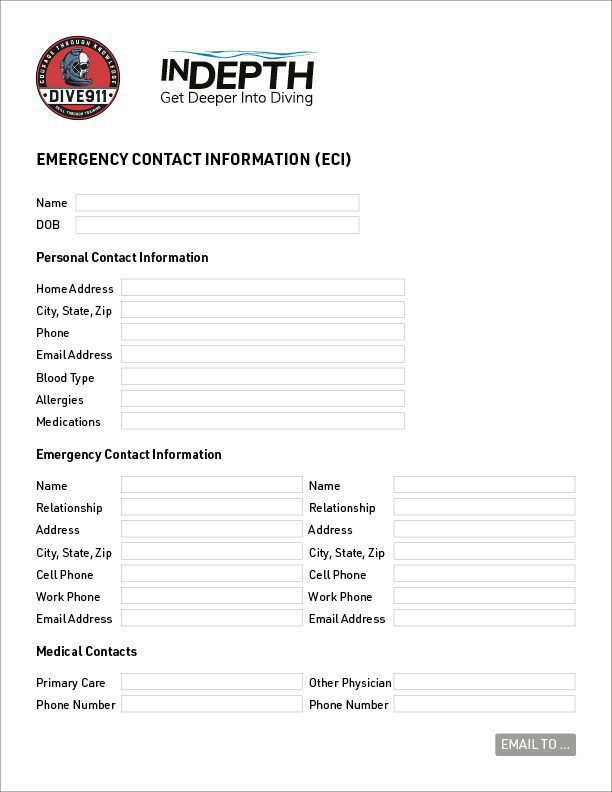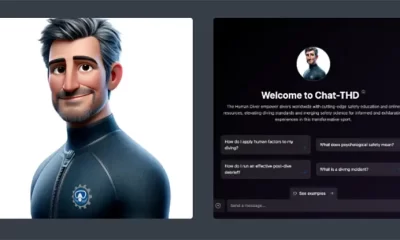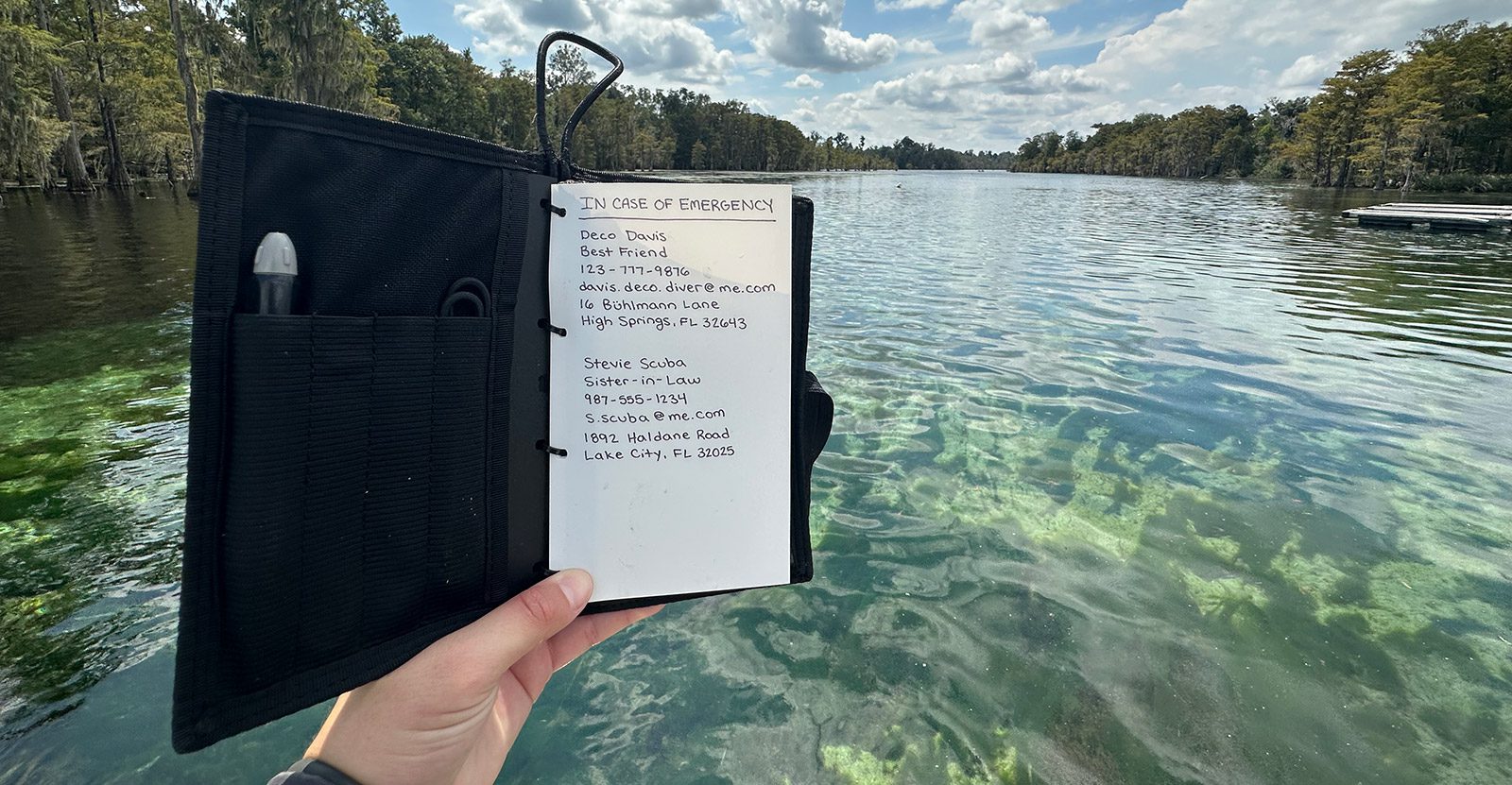
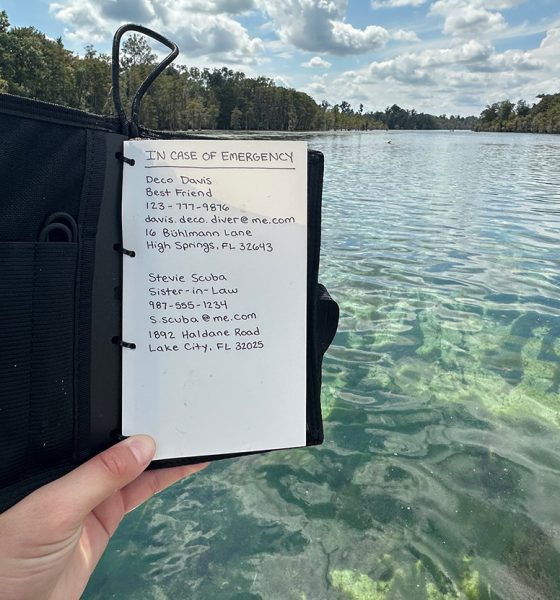
Diving Safety
Who You Gonna Call (in an Emergency)?
In the immediate aftermath of a diving fatality, law enforcement needs to locate an emergency contact for the accident victim. If that person’s phone is locked, social media accounts private, and there’s no emergency contacts for friends or family, it will likely fall to you as a dive buddy, to locate the needed critical information. This can add unbearable stress to an already bad situation. The solution is to be prepared, as Buck Buchanan and Wally Endres with Christine Tamburri and Robert Zink explain.
by Buck Buchanan and Wally Endres with Christine Tamburri and Robert Zink. Images courtesy of the authors unless noted.
According to the 2020 DAN Annual Diving Report, 189 diver fatalities were reported in 2018 across all categories, including recreational, technical, breath-hold, commercial, public safety, and military diving operations. There were 228 diver fatalities reported in 2017. Despite the 17% decrease in fatalities from 2017 to 2018, divers are still dying and there is a lot to learn from these incidents.
Dive accidents happen, not only to reckless divers, but also to the most cautious, most well prepared, most highly trained divers in the world. While we may not want to think about it, the reality is that dive-related emergencies can happen at any time to any diver on any dive. Because of this possibility, all divers should be proactive in their efforts to mitigate the effects of chaos and confusion being added to those of shock and grief.
Whether a diver experiences a minor injury or is the unfortunate victim in a fatal accident, the need for easily accessible and reliable emergency contact information is crucial. This article dives into the importance of such precautions as well as provides specific tips for how to carry them out.
Why is Emergency Contact Information (ECI) important?
Imagine you and a buddy are on a weekend diving getaway. You could be in your home town or half-way around the world. Nevertheless, the sun is shining, the water is crystal clear, and all is well with the world. Soon after submerging, tragedy strikes, and your buddy—maybe even your best friend—never resurfaces. Suddenly, your perfect day has changed your life forever. What happens next can be handled either efficiently or chaotically, depending on the emergency contact information (ECI) on hand.
In the immediate aftermath of a tragedy, law enforcement needs to locate an emergency contact for the accident victim. If that person’s phone is locked with no known passcode, their social media accounts are private, and nothing in their wallet or on their dive gear points to any ECI for friends or family, you as the dive buddy, will need to help locate critical information. Doing this, while dealing with your own shock, adds almost unendurable stress.
Law enforcement’s primary role in any fatality investigation is to secure evidence, to identify the victim, to determine cause of death, and to make proper notifications to next-of-kin. This standard process changes in most, if not all, diving accidents that result in a death because most law enforcement agencies are either ill-equipped, untrained, or unaccustomed to handling a diving fatality.
Consequently, the more identifying information available, the easier it is for law enforcement to be effective. It should also be noted that most law enforcement agencies are not equipped to properly secure an underwater crime scene or to recover a deceased diver at depths.
ECI is a crucial piece of documentation. When a victim is seriously injured or dies, the need to contact someone in their network is necessary to initiate the next steps in the process. These steps may include providing a medical history to help EMS respond accordingly, arranging transportation home from a remote dive site, and/or notifying loved one(s).
Without ECI, an injured diver may be left on their own for hours. In cases where they are unable to advocate for themselves, medical professionals may be forced to make uninformed decisions for care. In the unfortunate case of a fatality, the lack of accessible ECI may mean that families are unaware for hours, days, or even weeks, not knowing the fate of their loved one.
Planning ahead and ensuring that ECI is available is part of “getting our affairs in order.” Divers should make available all vital information needed to assure that their loved ones will be reached in a timely manner.
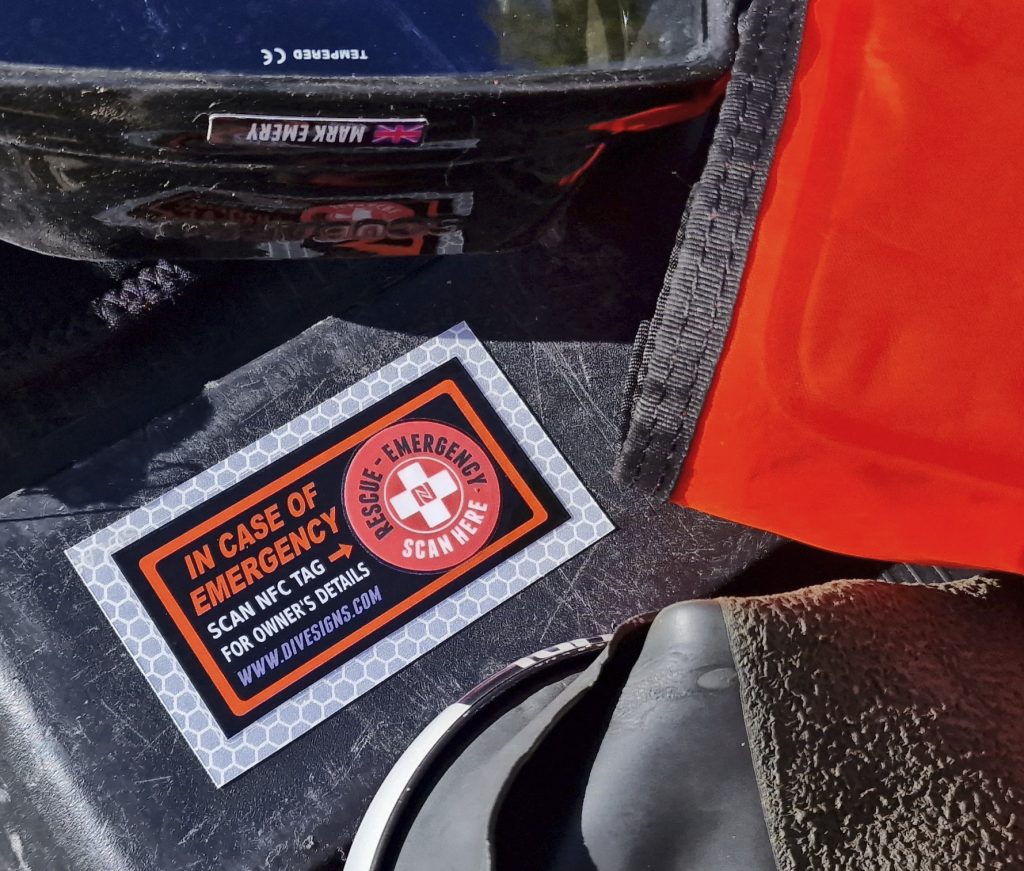
Emergency Contact (Point of Contact) vs. Next-of-Kin
An emergency contact can be a close friend, a relative, a co-worker, a neighbor, a dive buddy, a mentor, a pastor, or other trusted persons in your life. Remember, naming an emergency contact is not to be taken lightly. This is the person that will be contacted in the event of an unexpected, life-changing event, and often this individual will be the one tasked with informing other people close to the accident victim.
A next-of-kin contact is the closest living relative to the injured or deceased. In some cases, this person may have legal authority to make decisions.
It is important to understand the difference between these two terms so that a diver can choose who to list as their emergency contact. News of this nature is very traumatic for all loved ones, especially significant others. Certified divers understand the inherent risks that they are taking. Even if family members who are not divers think they understand the risks, the shock of losing a loved one is devastating. It may, however, be less traumatic if that horrible news comes from someone familiar to them. For example, the diver may choose to list their best friend as their emergency contact, knowing that a friendly face can soften the tragic news. With this information available, law enforcement would notify the listed emergency contact, and that person would notify the spouse or close loved one.
In the event that there could be estate or legal implications, the decision to use next-of-kin as the emergency contact should be considered carefully.
The More Information the More Efficient
The Emergency Contact
After deciding who is to be listed, it is critical to obtain their most up-to-date contact information. At minimum, the following information should be listed and easily accessible:
- Full Name of the Person to be Contacted
- Relationship of the Person to be Contacted
- Phone Number(s) of the Person to be Contacted
In addition, it is recommended that the following information also be included:
- Email Address of the Person to be Contacted
- Full Street Address of the Person to be Contacted
The more information available, the easier it will be for medical staff or law enforcement to understand the full scope of the relationship between the injured individual and the emergency contact.
Personal Information
It is important to remember that a situation does not instantly resolve when an emergency contact is reached. All divers should be proactive in their approach to ensure that medical staff and law enforcement have quick and easy access to not only ECI in the event of an incident, but to personal information as well. The next section discusses ways in which to house these details but, at minimum, the following personal data should be accessible:
- Full Name
- Date of Birth
- Phone Number
- Email Address
- Full Street Address
- Primary Care Physician Contact Information
- Pertinent Medical History (i.e., Known Allergies, Recent Surgeries, etc.)
- Blood Type
Solutions for All Divers
Gathering ECI and personal information are just two steps in the process of preparing for the event of a dive accident. To be of value, these pieces of information must be easy to obtain quickly. Divers need to be aware that, for their buddies and fellow divers, being unable to contact someone close to an injured or deceased diver is the last place they want to be in the aftermath of a traumatic experience.
These following lists are not comprehensive, but represent simple solutions that all divers can start using TODAY to ensure their ECI and personal information are able to be accessed at a moment’s notice.
Emergency Contact Options
Smartphone Emergency Contact Features (Apple/Android)

Both platforms offer many features that typically include emergency access to a medical ID in the event that the owner becomes incapacitated. Although most people are unaware that this is available, in most cases, a quick internet search will give easy setup guidance.
To configure an iPhone with a Medical ID, follow these steps on Apple Support . To configure an Android with Emergency Contacts, follow these steps on Android Police.
Visible Gear Solutions
Divers love to label their gear for a number of reasons, but very few make their ECI easily accessible by adding it to their kit.
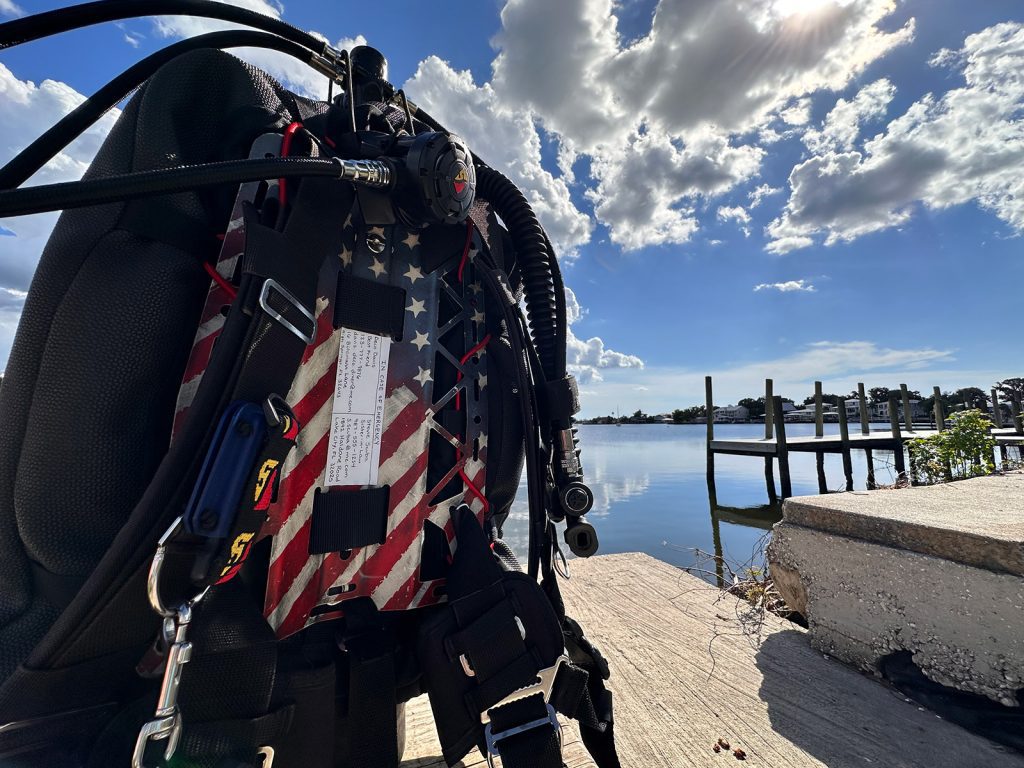
Duct Tape/Vinyl Tape
Some divers put a piece of tape on their backplate, canister light, or even cylinders that lists emergency contact information. This solution is fast, easy, and cheap.
Dog Tags
Dog tags can be attached to a backplate or sidemount harness, or even tucked into a set of wetnotes. These typically contain ECI, as well as one or two pieces of personal information (i.e., blood type, allergies, etc.).
Smart Emergency Stickers by Dive Signs
Technology buffs will love this commercially available option. Dive Signs has created a sticker that can be placed on any non-metal surface, such as on a dive crate, on a certification card, or maybe even on a drysuit bag, and it contains a near field communication (NFC) tag. With one tap of a smartphone, anyone can have access to pre-filled emergency contact and personal information that can be easily programmed by the diver. They can be purchased here: Smart Emergency Stickers
Wetnotes
Divers constantly need to communicate underwater. Most use hand signals, some use slates, but a common tool is wetnotes. ECI can be written on the first page for easy access after an incident.

Save-a-Dive Kit Solutions
In similar fashion to labeling dive gear, duct tape/vinyl tape can be put on the inside lid of a save-a-dive kit to list ECI. As an alternative, a printed or hand-written list (preferably laminated) can be used. It should be noted that this method likely won’t do any good if the dive buddy doesn’t know it exists and its location.
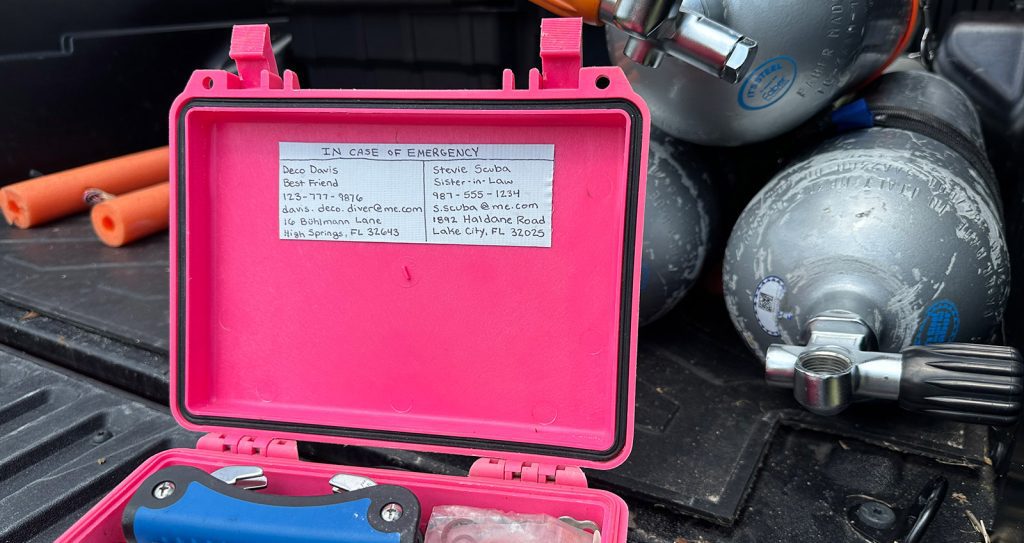
State-Specific Databases
These opt-in systems are put in place for law enforcement in the event of an emergency and they are typically linked to a driver’s license. At this time, these services are only available in a few US states, with Florida having over 19 million participants.
Personal Information
Fillable Form
The following form can be filled in, then printed and placed in a known location so that it is easy to access in the event of an emergency.
You can download the form here: Dive911 ECI Form
Hand-Written List
The most basic form of documentation, this is easy to add to a save-a-dive kit, in the console of a car, or in another secure location. This list can also be printed and laminated so that it is durable and easy to read.
Emergency Binder
Some divers may opt for advanced directives that provide instructions for medical care and only go into effect if the injured diver cannot communicate their own wishes. An emergency binder may contain additional information, including passwords, financial and insurance information, a will, and/or government documents such as a passport and social security information. If this route is taken, it is important to understand who has access to this information and when it is invoked.
ID Tag
The Divers Alert Network (DAN) Medical ID Tags offer divers an easy way to display important information that may help medical personnel respond quicker and more effectively in the event of a dive emergency. An ID tag displays a diver’s name, DAN ID number, date of birth, drug allergies, and an emergency contact. This information can help public safety officials make informed decisions about their care, even if they are unable to advocate for themselves.
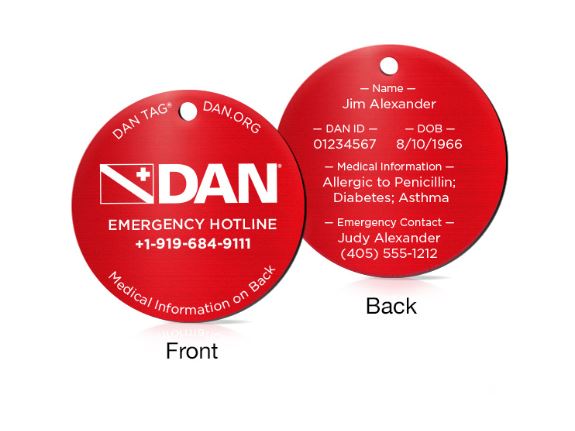
Best Practices
Each individual diver will have their own method of listing an emergency contact and ensuring their personal details are comprehensive and accessible. Some divers may use suggestions from the lists above, and some divers may design their own ways of housing this important information. Regardless of the documentation method, there are three important points to remember:
List More than One (1) Emergency Contact
Life happens, and sometimes even the most reachable individual is away from their phone, so it is important to list more than one emergency contact.
Update Information when Anything Changes and Review on an Annual Basis
Information is only useful if it is kept up-to-date. Any time information changes, it should be updated on the emergency contact sheet or a personal information list. It is also good practice to review all information on an annual basis to ensure that it is accurate. An easy way to remember to review this information is at the same time as an annual cylinder visual inspection. In addition, the diver should ask their emergency contact to update them with any changes they might have.
Never List a Dive Buddy as an Emergency Contact
This one may seem obvious, but on any given day, one dive buddy has the other listed as an emergency contact. Unsurprisingly, this becomes useless if either buddy has an incident on the dive. As such, it is best practice to list someone who is never a dive buddy as an emergency contact and, again, to verify and update both your and their details.
No one expects an accident to happen to them.The fact is that even the most cautious diver may one day find themself in the middle of an incident, needing quick access to emergency information. All divers are encouraged to be proactive and to ensure that ECI and personal information are accurate and readily accessible. Making a conscious effort during all pre-dive briefs to discuss where and how to access ECI in the event of an emergency is good practice.
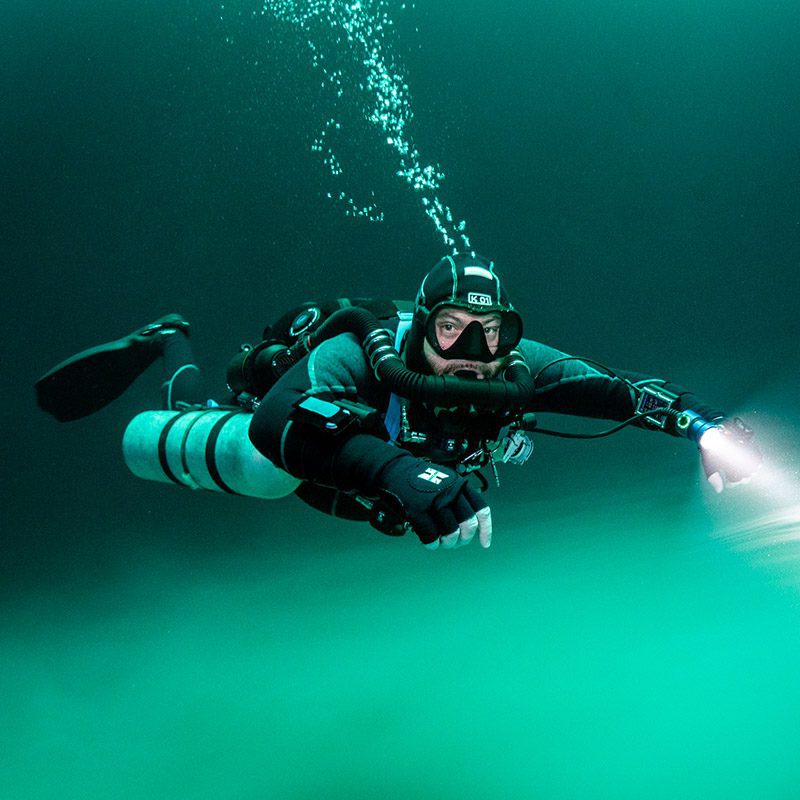
This article is dedicated to Ben Strelnick (NREMT, W-EMT) who died on May 26, 2023, while cave diving at Jackson Blue Spring in Marianna, Florida. He was a medic at Divers Alert Network (DAN), and was an avid diver who always put others before himself. The inspiration for this article was drawn from the lack of ECI following Ben’s death and the hardships that followed. Ben wanted nothing more than for people to dive and to do it safely, and he would without a doubt encourage others to plan ahead so that their future dive buddies, friends, and family could get through any type of tragedy with as little pain as possible.
About The Authors




Buck Buchanan and Wally Endres (NREMT, DMT) are co-owners of Dive911, LLC, a Central Florida-based dive training facility that specializes in instructor professional development and public safety pedagogy. Buck is an SDI/ERDI Instructor Trainer Evaluator and Ambassador who has 35+ years of experience in teaching, commercial diving, and heavy salvage. Wally is a Course Director, Public Safety Instructor, and former law enforcement officer who has 25+ years of experience in risk management operations and OSHA compliance consulting. Christine Tamburri (SDI Instructor) and Robert Zink (former law enforcement officer and crash reconstructionist) were also consulted in the composition and viewpoints of this article.




















